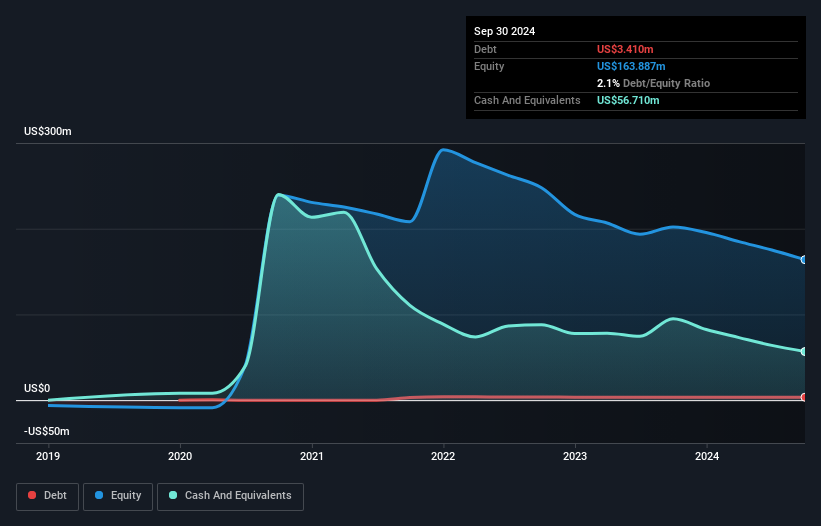- United States
- /
- Healthcare Services
- /
- NasdaqGM:NNOX
Is Nano-X Imaging (NASDAQ:NNOX) Weighed On By Its Debt Load?
Warren Buffett famously said, 'Volatility is far from synonymous with risk.' So it might be obvious that you need to consider debt, when you think about how risky any given stock is, because too much debt can sink a company. Importantly, Nano-X Imaging Ltd. (NASDAQ:NNOX) does carry debt. But is this debt a concern to shareholders?
When Is Debt A Problem?
Debt and other liabilities become risky for a business when it cannot easily fulfill those obligations, either with free cash flow or by raising capital at an attractive price. Ultimately, if the company can't fulfill its legal obligations to repay debt, shareholders could walk away with nothing. However, a more frequent (but still costly) occurrence is where a company must issue shares at bargain-basement prices, permanently diluting shareholders, just to shore up its balance sheet. By replacing dilution, though, debt can be an extremely good tool for businesses that need capital to invest in growth at high rates of return. When we examine debt levels, we first consider both cash and debt levels, together.
Check out our latest analysis for Nano-X Imaging
What Is Nano-X Imaging's Debt?
As you can see below, Nano-X Imaging had US$3.41m of debt, at September 2024, which is about the same as the year before. You can click the chart for greater detail. However, it does have US$56.7m in cash offsetting this, leading to net cash of US$53.3m.

A Look At Nano-X Imaging's Liabilities
The latest balance sheet data shows that Nano-X Imaging had liabilities of US$13.0m due within a year, and liabilities of US$7.03m falling due after that. On the other hand, it had cash of US$56.7m and US$1.49m worth of receivables due within a year. So it can boast US$38.1m more liquid assets than total liabilities.
This short term liquidity is a sign that Nano-X Imaging could probably pay off its debt with ease, as its balance sheet is far from stretched. Simply put, the fact that Nano-X Imaging has more cash than debt is arguably a good indication that it can manage its debt safely. There's no doubt that we learn most about debt from the balance sheet. But it is future earnings, more than anything, that will determine Nano-X Imaging's ability to maintain a healthy balance sheet going forward. So if you want to see what the professionals think, you might find this free report on analyst profit forecasts to be interesting.
Over 12 months, Nano-X Imaging reported revenue of US$11m, which is a gain of 11%, although it did not report any earnings before interest and tax. That rate of growth is a bit slow for our taste, but it takes all types to make a world.
So How Risky Is Nano-X Imaging?
Statistically speaking companies that lose money are riskier than those that make money. And the fact is that over the last twelve months Nano-X Imaging lost money at the earnings before interest and tax (EBIT) line. Indeed, in that time it burnt through US$41m of cash and made a loss of US$50m. But at least it has US$53.3m on the balance sheet to spend on growth, near-term. Even though its balance sheet seems sufficiently liquid, debt always makes us a little nervous if a company doesn't produce free cash flow regularly. When analysing debt levels, the balance sheet is the obvious place to start. But ultimately, every company can contain risks that exist outside of the balance sheet. For example - Nano-X Imaging has 1 warning sign we think you should be aware of.
Of course, if you're the type of investor who prefers buying stocks without the burden of debt, then don't hesitate to discover our exclusive list of net cash growth stocks, today.
Valuation is complex, but we're here to simplify it.
Discover if Nano-X Imaging might be undervalued or overvalued with our detailed analysis, featuring fair value estimates, potential risks, dividends, insider trades, and its financial condition.
Access Free AnalysisHave feedback on this article? Concerned about the content? Get in touch with us directly. Alternatively, email editorial-team (at) simplywallst.com.
This article by Simply Wall St is general in nature. We provide commentary based on historical data and analyst forecasts only using an unbiased methodology and our articles are not intended to be financial advice. It does not constitute a recommendation to buy or sell any stock, and does not take account of your objectives, or your financial situation. We aim to bring you long-term focused analysis driven by fundamental data. Note that our analysis may not factor in the latest price-sensitive company announcements or qualitative material. Simply Wall St has no position in any stocks mentioned.
About NasdaqGM:NNOX
Nano-X Imaging
Develops a commercial-grade tomographic imaging device with a digital X-ray source.
Excellent balance sheet with limited growth.
Market Insights
Community Narratives



